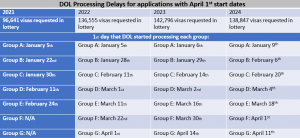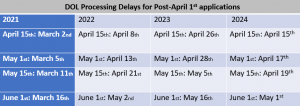The purpose of this Client Alert is to provide additional information and next steps for summer-season H-2B employers that may be interested in cap relief, as well as to provide a general update on DOL processing delays.
As a reminder, the government published a rule in December 2024 that provided for cap H-2B cap relief for the 2025 Fiscal Year. The rule allocated a total of 64,716 supplemental visas, divided between winter- and summer-season employers, which is outlined in more detail in the Client Alert attached to this email. More details about cap relief and strategy follow below.
Please note: this Client Alert does not impact winter-season employers. Additionally, if you are a summer-season employer who is only hiring “in-country” workers (i.e., workers who are transferring between H-2B employers within the U.S.), then the information about the supplemental cap in this Client Alert is not applicable to you, as in-country workers are “cap-exempt” (the information regarding backlogs, on the other hand, impacts all summer employers).
Case Processing and Backlogs
Regarding visa processing, the U.S. Department of Labor (DOL) is currently working through the applications that were assigned various lottery groupings for April 1st start dates. On Saturday (February 1st), the government completed processing of the 33,000+ Group A cases and moved on to Group B. It seems like the DOL is experiencing similar backlogs and delays that were experienced last year (although the somewhat good news is that the DOL is a few days ahead of last year’s pace). However, we expect these delays to almost certainly result in delayed start dates for H-2B visa workers for April 1st employers with start dates in group E or later, as well as for employers with start dates after April 1st.
A chart of last year’s delays is shown below for reference (note: the dates are times that the DOL began processing each group). Final H-2B petition approval by USCIS is typically around 4 weeks after a specific case receives a Notice of Acceptance (NOA) from DOL.


Cap Relief
Because the DOL has completed initial processing of April 1st Group A cases, it is time for summer-season employers to begin thinking about cap relief (i.e., petitions for supplemental out-of-country visas). As a reminder, the government split the supplemental visas for summer-season employers into three categories: (1) 19,000 early-season returning worker visas; (2) 5,000 late-season returning worker visas; and (3) 20,000 Special Allocation Country visas (available on a “first-come, first-served” basis regardless of employment start date). Again, more details regarding the different categories of allocations can be found in original December 2024 Client Alert (attached). Given that the visas are broken down partially by start date (early-season and late-season employers), this Client Alert does the same.
More details and timeline for early-season filers (i.e., April 1st start date):
- What are the options: If your organization has an April 1st start date and did not get a favorable lottery assignment but you are still interested in hiring out-of-country (i.e., cap-subject) H-2B workers, there are two options – (1) file under the returning worker allocation for workers from any country who have had a visa in the past three fiscal years; or (2) file under the Special Allocation for any workers from any of those countries (Colombia, Costa Rica, Ecuador, El Salvador, Guatemala, Haiti, and Honduras).
- Please remember that in-country recruiting is the best option whenever possible, as it allows you to sidestep the cap entirely and avoids the risks associated with supplemental cap petitions (“irreparable harm” and audits – see below).
- Also, please note that recruiting workers from the Special Allocation countries could be somewhat more difficult/delayed this year due to the recent freeze on federal foreign aid – please see our recent Client Alert regarding the “Executive Order freezing foreign aid” for more details.
- Strategy: It is difficult to predict with certainty the best strategy to pursue because there are many unknown factors. That being said, based on last year, the Returning Worker supplemental visas were taken quickly. The Special Allocation visas, on the other hand, have been historically less sought after, and this allocation remained open for the entire summer last year.
- For April 1st filers: last year, Group D was the cutoff for employers who sought Returning Worker supplemental visas (and only around half of Group D employers made it). By the time Group E employers were able to file, the Returning Worker allocation was fully exhausted (by employers in Groups A-D). Therefore, some employers in Group D, and employers in Groups E and beyond, who are interested in cap relief should explore workers from the Special Allocation countries, as this may be the only allocation that remains open.
- Note for post-April 1st “early-season” filers: If your organization has a start date after April 1st but before May 15th, the 19,000 “early season” Returning Worker visas will almost certainly be gone, as they will be fully claimed by April 1st filers. Therefore, the only option will be to request Special Allocation visas, assuming those remain available as we expect.
- Timing: Supplemental visas (whether “returning worker” or “Special Allocation”) can be requested by “early-season” filers beginning 15 days after the initial H-2B cap is reached. Last year, the cap was hit on March 7th, which is a good estimate again this year. Therefore, employers will most likely be able to file petitions in mid-March.
- Requirements: You must have open spots left on your H-2B certification and must sign an attestation that your organization will experience irreparable harm (i.e., permanent and severe financial loss) if it cannot hire all of the H-2B workers requested. If filing for “returning worker” visas, you must be able to prove that the worker held an H-2B visa in the past 3 Fiscal Years.
- Note re: irreparable harm: the government has been increasing audits and more heavily scrutinizing claims of “irreparable harm.” Therefore, this requirement should not be taken lightly.
- Fees: Due to the additional work and special procedures involved in submitting the supplemental cap petitions, our legal fee to file under cap relief will be $2,000 USD per petition this year and there is a $175 USD mail fee (these are in addition to the base legal, filing, and mailing fees that may have already been invoiced for standard petitions).
More details and timeline for late-season filers (i.e., May 15th and later start dates):
- What are the options: If your organization has a May 15th start date (or later) and is interested in hiring out-of-country (i.e., cap-subject) H-2B workers, there are potentially two options: (1) file under the “late-season” returning worker allocation for workers from any country who have had a visa in the past three fiscal years; or (2) file under the Special Allocation for any workers from any of those countries.
- Please remember that in-country recruiting is the best option whenever possible, as it allows you to sidestep the cap entirely and avoids the risks associated with supplemental cap petitions (“irreparable harm” and audits – see below).
- Also, please note that recruiting workers from the Special Allocation countries could be somewhat more difficult/delayed this year due to the recent freeze on federal foreign aid – please see our recent Client Alert regarding the “Executive Order freezing foreign aid” for more details.
- Strategy: Due to the existence of unknown variables, it is difficult to predict with certainty with strategy to pursue. Last year, both the late-season returning worker allocation and the Special Allocation remained open for the summer. However, we anticipate increased demand for the late-season returning worker allocation this year. Therefore, while we still believe that employers with May 15th start dates are likely to have both allocations as options, employers with start dates later in May or June may not.
- Timing: Supplemental visas (whether “returning worker” or “Special Allocation”) can be requested by “late-season” filers beginning 45 days after the initial H-2B cap is reached. Last year, the cap was hit on March 7th, which is a good estimate again this year. Therefore, late-season employers will most likely be able to file petitions in mid-April.
- Requirements: You must have open spots left on your H-2B certification and must sign an attestation that your organization will experience irreparable harm (i.e., permanent and severe financial loss) if it cannot hire all of the H-2B workers requested. If filing for “returning worker” visas, you must be able to prove that the worker held an H-2B visa in the past 3 Fiscal Years.
- Note re: irreparable harm: the government has been increasing audits and more heavily scrutinizing claims of “irreparable harm.” Therefore, this requirement should not be taken lightly.
- Fees: Due to the additional work and special procedures involved in submitting the supplemental cap petitions, our legal fee to file under cap relief will be $2,000 USD per petition this year and there is a $175 USD mail fee (these are in addition to the base legal, filing, and mailing fees that may have already been invoiced for standard petitions).
Please let us know if you have any questions.
Thank you,
Keith and the Pabian Law Team